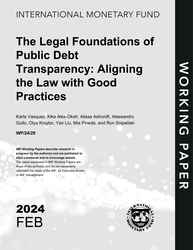
The Legal Foundations of Public Debt Transparency: Aligning the Law with Good Practices
The Legal Foundations of Public Debt Transparency
READ MORE...
Volume/Issue:
Volume 2024
Issue 029
Publication date: February 2024
ISBN: 9798400267222
$20.00
Add to Cart by clicking price of the language and format you'd like to purchase
Available Languages and Formats
| English | |||
| French | |||
| Portuguese | |||
| Spanish |
Prices in red indicate formats that are not yet available but are forthcoming.
Topics covered in this book
This title contains information about the following subjects.
Click on a subject if you would like to see other titles with the same subjects.
Investments and Securities-General , Economics- Macroeconomics , Public Finance , Economics / General , sovereign debt , transparency , disclosure , legal institutions , debt transparency , debt opacity , statistics guide , debt bulletin , debt manager , address debt vulnerability , debt Registry , Government debt management , Debt management , Securities , Middle East and Central Asia , Global , Asia and Pacific
Summary
Debt opacity burdens the public and can exacerbate debt vulnerabilities in many countries. Both low-income and developing countries and emerging market economies have critical gaps in debt transparency, and the implementation of international standards and guidelines has lagged. The paper surveys the legal frameworks of sixty jurisdictions and reveals the critical weaknesses that hinder debt transparency, which include weak reporting obligations, limited coverage of public debt, inadequate monitoring, unclear borrowing and delegation processes, unfettered confidentiality arrangements and weak accountability mechanisms. Because laws entrench practices and bind the discretion of policy makers and debt managers alike, subjecting them to public scrutiny, legal reform is a necessary part of any solution to the problem of hidden debt, though it may entail a difficult and time intensive process in many jurisdictions.
Copyright © 2010 - 2025
Powered by:
AIDC



